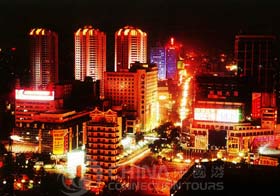 Zhengzhou is the capital of Henan Province. Located in the middle of China, it is an important transportation hub and home to the national grain wholesale market.
Zhengzhou is the capital of Henan Province. Located in the middle of China, it is an important transportation hub and home to the national grain wholesale market.
The city has a total area of 7,446 square kilometers, with an urban area of 1,010 square kilometers. Situated south of the Yellow River and east of the Songshan River, Zhengzhou enjoys temperate continental climate with four distinct seasons. The average annual temperature is 14.4 degrees Celsius, and the city receives an average annual rainfall of 641 millimeters with 220 frost-free days.
Zhengzhou has a population of 6.6 million, with 2.05 million in the urban area. The main inhabitants are Han, and the main religion is Buddhism and Taoism. The natives speak a local dialect, but the government language is still Mandarin.
 As one of China's earliest cities, Zhengzhou may have been the second capital of the Shang dynasty some 3,500 years ago. In the Spring and Autumn period, it was the capital of the Zheng and Han States, which lasted 500 years. Zhengzhou's status as a transport and economic center has roots as far back as the Sui and Tang dynasties (late 6th to early 10th century), when canals connected Zhengzhou's grain markets to the Yellow River. Zhengzhou's importance declined along with nearby Luoyang after the Song established their capital at Kaifeng to the east. Zhengzhou emerged as a transportation hub again in the 20th century with the construction of railroad lines. It played an important role in the railroad strike in 1923 and has become one of Asia's most important freight transfer hubs.
As one of China's earliest cities, Zhengzhou may have been the second capital of the Shang dynasty some 3,500 years ago. In the Spring and Autumn period, it was the capital of the Zheng and Han States, which lasted 500 years. Zhengzhou's status as a transport and economic center has roots as far back as the Sui and Tang dynasties (late 6th to early 10th century), when canals connected Zhengzhou's grain markets to the Yellow River. Zhengzhou's importance declined along with nearby Luoyang after the Song established their capital at Kaifeng to the east. Zhengzhou emerged as a transportation hub again in the 20th century with the construction of railroad lines. It played an important role in the railroad strike in 1923 and has become one of Asia's most important freight transfer hubs.

